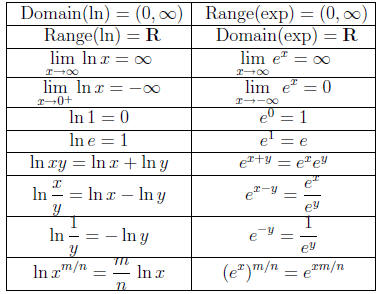The Natural Exponential Function
The definition. The natural logarithm function ln x
is an increasing function whose domain
is the open interval (0,∞) and whose range is R, all of the real numbers. Since
it’s increasing,
therefore it’s one-to-one and has an inverse, the natural exponential function,
which we denote
exp x. Soon we’ll also denote it ex, but as that notation already has
a meaning when x is a
rational number, we’ll have to show exp x agrees with ex for rational
x.
Now, exp is inverse to ln, and that means
exp x = y iff x = ln y.
Let’s start by showing exp(m/n) = em/n for rational numbers m/n so we
can use the
usual exponential notation. We know that

But since exp is inverse to ln, that statement is equivalent to

which is what we wanted to show.
Now we can use the usual exponential notation, but be aware that exp is still
used when
the exponent is complicated. For instance, a notation like
 is preferred by many
is preferred by many
over  .
.
Properties of the natural exponential function. That the natural
exponential function
is inverse to the natural log now reads
| ex = y iff x = ln y |
From this logical equivalence, every statement about ln
can be converted to a statement
about ex.
Here’s a table with properties of ln and exp.

The first few lines in the table are direct translations
of the properties of ln into properties
of exp. The later ones are almost direct, but not quite. For example, let’s see
how the identity
ln xy = ln x+ln y implies the identity  . It
would help to change the variables in one
. It
would help to change the variables in one
of the identities since they don’t exactly correspond. Let’s show the identity
ln xy = ln x+ln y
implies the identity  .
.
Let s = ln x so that x = es, and let t = ln y so that y = et.
Since ln xy = ln x + ln y,
therefore s + t = ln x + ln y = ln xy. That implies
 , which equals eset,
and that was
, which equals eset,
and that was
what we wanted to show.
Note that the final equation in the right column of the table,
 is not quite
is not quite
satisfactory. We would prefer to have  for
any real number y, not just for rational
for
any real number y, not just for rational
y = m/n, but we haven’t yet defined what  would mean since we have only defined
would mean since we have only defined
exponentiation when the base is e, not when the base is an arbitrary real number
like ex.
That comes soon.
The derivative and integral of the natural exponential function. Recall
that, for
positive x,  , that is,
, that is,
 . Let’s use that information to determine
. Let’s use that information to determine
the derivative and integral of ex. We’ll use the inverse function
theorem for derivatives to to
that.
The inverse function theorem says that if y = f(x) so that x = f -1(y),
then

that is,

Right now, we have y = f(x) = ln x, x = f -1(y)
= ey, and f'(x) = 1/x. We want to find the
derivative of ey, that is,  . By
the inverse function theorem, that
. By
the inverse function theorem, that
equals

Thus, the derivative  of the exponential function ey is itself ey. If we switch
to x as the
of the exponential function ey is itself ey. If we switch
to x as the
independent variable, we can write this result as the exponential rule for
derivatives

It is this property of the exponential function that gives
it lots of applications in science.
Frequently, an exponential function has an exponent that is not just the
variable x, but
a function of x, for instance  . To find its
derivative, use the exponential rule for
. To find its
derivative, use the exponential rule for
derivatives along with the chain rule: 
More generally,

We can immediately use the exponential rule for
derivatives,  , to integrate the
, to integrate the
exponential function.



